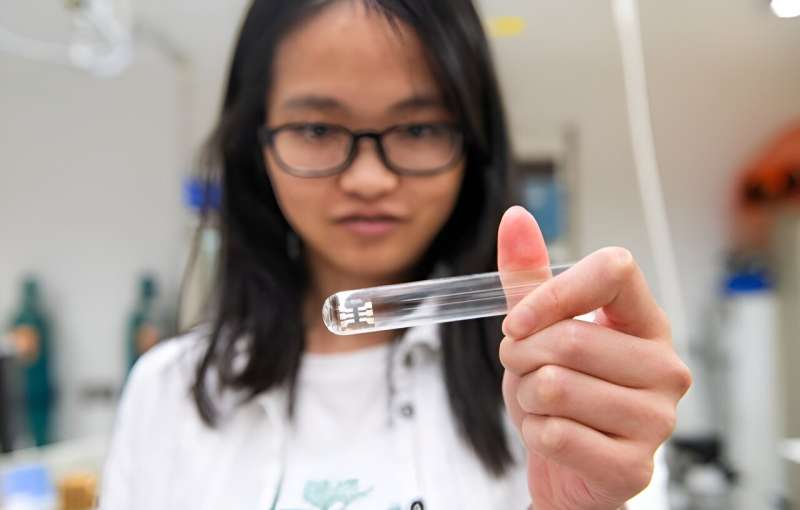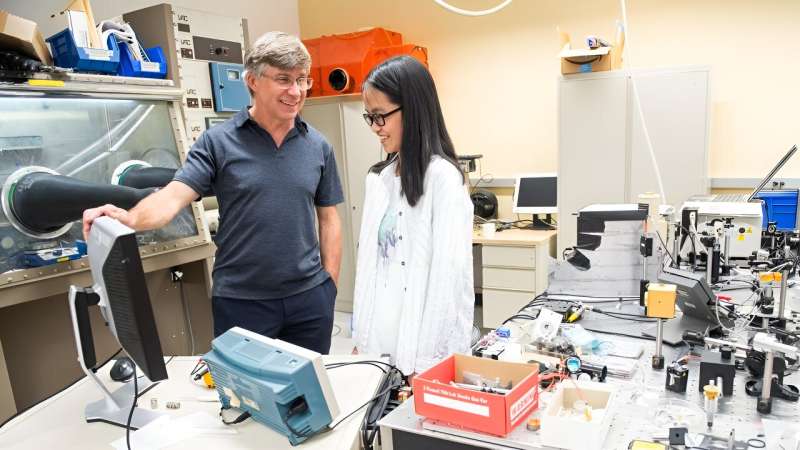by Louise Lerner, University of Chicago

Scientists with the University of Chicago have demonstrated a way to create infrared light using colloidal quantum dots. The researchers said the method demonstrates great promise; the dots are already as efficient as existing conventional methods, even though the experiments are still in early stages.
The dots could someday form the basis of infrared lasers as well as small and cost-effective sensors, such as those used in exhaust emissions tests or breathalyzers.
“Right now the performance for these dots is close to existing commercial infrared light sources, and we have reason to believe we could significantly improve that,” said Philippe Guyot-Sionnest, a professor of physics and chemistry at the University of Chicago, member of the James Frank Institute, and one of three authors on the paper published in Nature Photonics. “We’re very excited for the possibilities.”
The right wavelength
Colloidal quantum dots are tiny crystals—you could fit a billion into the period at the end of this sentence—that emit different colors of light depending on how big you make them. They’re very efficient and easy to make and are already being used in commercial technology; you might already have bought a quantum-dot TV without knowing it.
However, those quantum dots are being used to make light in the visible wavelength—the part of the spectrum humans can see. If you wanted quantum dot light in the infrared wavelength, you’ve mostly been out of luck.
But infrared light has a lot of uses. In particular, it is very useful for making sensors. If you want to know whether harmful gases are coming out of your car exhaust, or test whether your breath is above the legal alcohol limit, or make sure methane gas isn’t coming out of your drill plant, for example, you use infrared light. That’s because different types of molecules will each absorb infrared light at a very specific wavelength, so they’re easy to tell apart.
“So a cost-effective and easy-to-use method to make infrared light with quantum dots could be very useful,” explained Xingyu Shen, a graduate student and first author on the new study.

Infrared lasers now are made through a method called molecular epitaxy, which works well but is labor- and cost-intensive. The scientists thought there might be another way.
Guyot-Sionnest and his team have been experimenting with quantum dots and infrared technology for years. Building on their previous inventions, they set out to try to recreate a “cascade” technique that is widely used to make lasers, but had never been achieved with colloidal quantum dots.
In this “cascade” technique, researchers run an electrical current across a device, which sends millions of electrons traveling across it. If the architecture of the device is just right, the electrons will travel through a series of distinct energy levels, like falling down a series of waterfalls. Each time the electron falls down an energy level, it has the chance to emit some of that energy as light.
The researchers wondered if they could create the same effect using quantum dots. They created a black “ink” of trillions of tiny nanocrystals, spread it onto a surface and sent an electrical current through.
“We thought it would be likely to work, but we were really surprised by how well it worked,” said Guyot-Sionnest. “Right away, from the first time we tried it, we saw light.”
In fact, they found that the method was already as efficient as other, conventional ways to produce infrared light, even in exploratory experiments. With further tinkering, the scientists said, the method could easily surpass existing methods.
Potential applications
They hope the discovery could lead to significantly cheaper infrared lights and lasers, which could open up new applications.
“I think it’s one of the best examples of a potential application for quantum dots,” said Guyot-Sionnest. “Many other applications could be achieved with other materials, but this architecture really only works because of the quantum mechanics. I think it’s pushing the field forward in a really interesting way.”
More information: Xingyu Shen et al, Mid-infrared cascade intraband electroluminescence with HgSe–CdSe core–shell colloidal quantum dots, Nature Photonics (2023). DOI: 10.1038/s41566-023-01270-5
Journal information: Nature Photonics
Provided by University of Chicago

